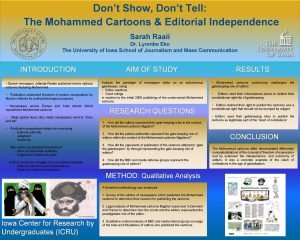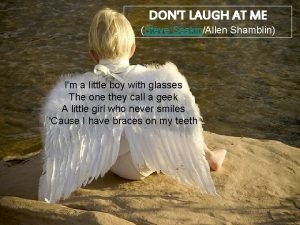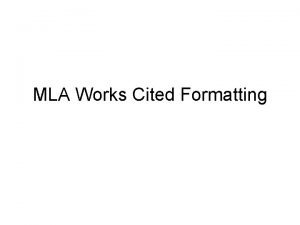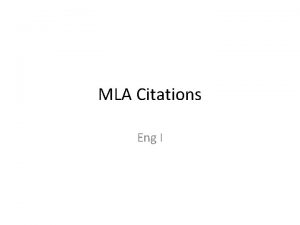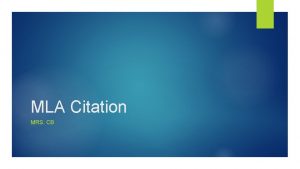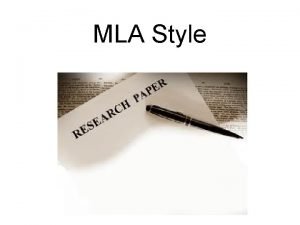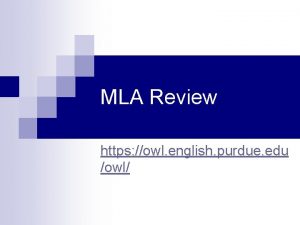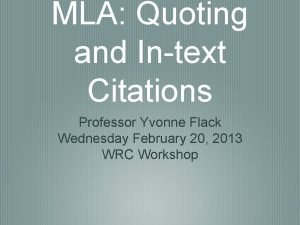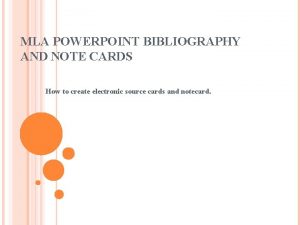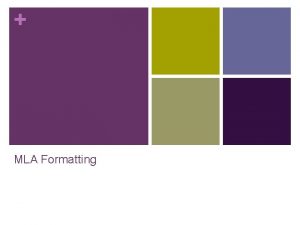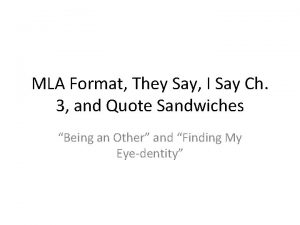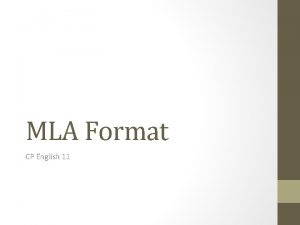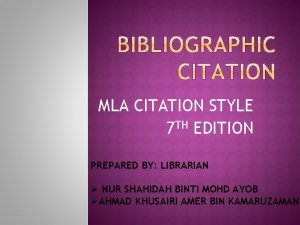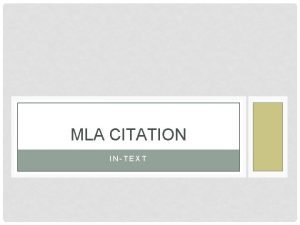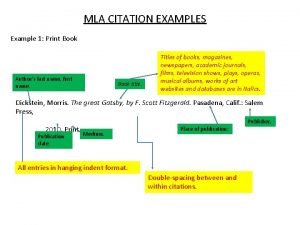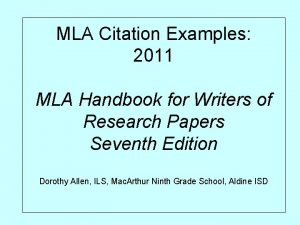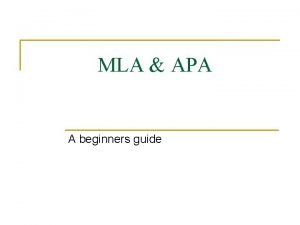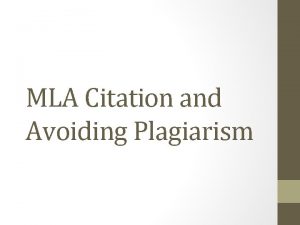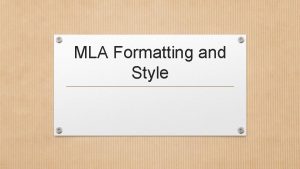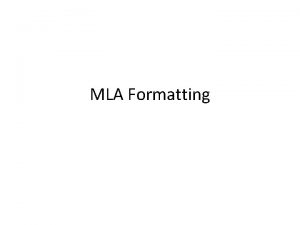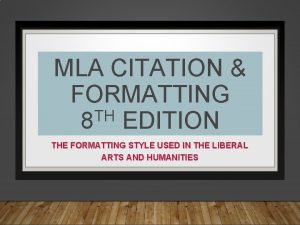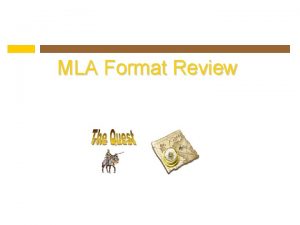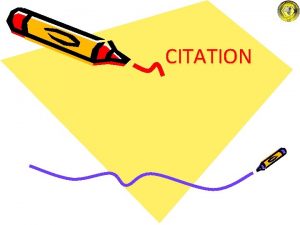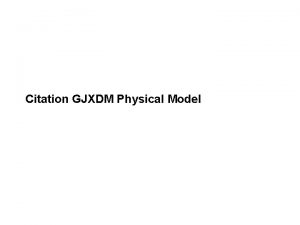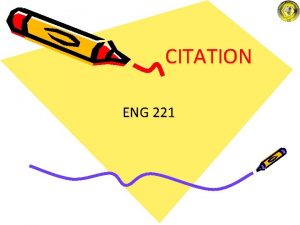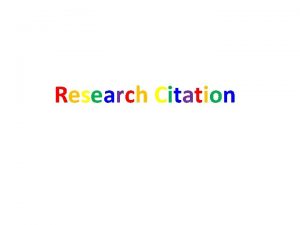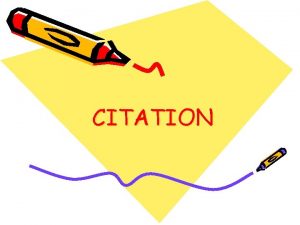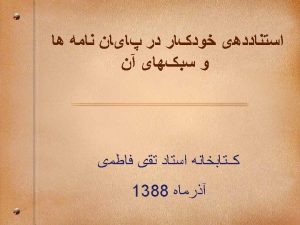Formatting and Citation Review MLA Formatting Dont forget


















- Slides: 18

Formatting and Citation Review

MLA Formatting • Don’t forget to add a header. • Click “insert” & pick the “page number” that’s in the upper right of the page; then type your last name and a space. • Check that it’s in Times New Roman 12 font. • Highlight everything and set your spacing to 0 before, 0 after. Then you can choose double spaced.

Formal Language • Avoid using 1 st/2 nd person pronouns. • Eliminate “I”, “you, ” “us, ” and “we. ” • Avoid contractions (don’t, haven’t, etc). • You can write “cannot” or “will not, ” but do not write “can’t” or “won’t. ” • Stay in the present tense to discuss what HAPPENS in the book.

Short Quotations (under 4 lines) • Use quotation marks. • Provide the author and specific page citation in the text within a parenthetical reference. • Remove periods, commas, colons, & semicolons at the end of a quotation, but leave in question marks and exclamation points. • Then place the desired punctuation after the parenthetical.

Short Quote Examples • Huck states, “Humans can be awful cruel to each other” (Twain 45). • One of the most obvious themes in the novel is stated explicitly in the final chapter: "Be true!" (Hawthorne 184).

Rules for Long Quotes • If a passage is more than 4 lines when typed out, simply hit enter & then tab the whole block of text in 1” (hit tab twice). • A block quote doesn’t need quotation marks around it. However, if someone is speaking, leave the dialogue quotation marks in. • Now, leave the end punctuation alone, and let the parenthetical come after the closing punctuation mark!

Long Quotes: An Example There are many ways to view Pearl, Hester’s child. She may be Hester’s ticket to salvation, and Hester does often think of Pearl as her “only treasure” (Hawthorne 78); however, Hester also begins to worry that Pearl may be evil because the child is alive as a result of her sinful action: God, as a direct consequence of the sin which man […] punished, had given her a lovely child, whose place was on that same dishonored bosom, to connect her parent for ever with the race and descent of mortals, and to be finally a blessed soul in heaven! Yet these thoughts affected Hester Prynne less with hope than apprehension. She knew that her deed had been evil; she could have no faith, therefore, that its results would be for good. (Hawthorne 78) These thoughts of Hester’s demonstrate both sides of Pearl’s existence, the positive and the negative. She is both a gift and a burden.

Rules for Dialogue • Double (normal) quotation marks around the very outside edges of the quote show that YOU are quoting the book. • Single marks show that whatever is inside them is something SAID BY A CHARACTER. • You may quote something with narrator and dialogue, like this: “do dee do ‘blah’” (Hawthorne 33).

Dialogue Quote Example The youngest woman in the crowd at the scaffold is not nearly so harsh against Hester as the older women are. She seems to feel sorry for Hester when she says, “‘Ah, but, [. . . ] let her cover the mark as she will, the pang of it will be always in her heart’” (Hawthorne 36).

Want to add/change words for clarity’s sake? Use brackets! The sunlight, symbolizing hope, is always within Pearl’s reach, and this supports the idea that Pearl, too, represents hope. The narrator says, “to judge from the bright expression that was dancing on Pearl's features, her mother could have fancied that the child had absorbed [the sunlight] into herself, and would give it forth again, with a gleam about her path, as they should plunge into some gloomier shade” (Hawthorne 121).

Need to Remove Words? Use Brackets with an Ellipsis! After his speech, Dimmesdale calls out to Hester to help him climb the scaffold. He seems to need her strength to support him in completing the difficult task of confessing his sin: “‘Hester Prynne, [. . . ] come hither now, and twine thy strength about me! Thy strength, Hester; but let it be guided by the will which God hath granted me!’” (159).

Do I Cite Paraphrased Material? • Let’s say you’re talking about something that happened in the novel, some detail about a character or an event in the plot, but you are putting it into your own words. You are not using a direct quote from the novel… • SURPRISE! YOU STILL MUST CITE THE PAGE NUMBER(S)!

Citing Paraphrased Material… Example Hester and Dimmesdale decide to run away when they are in the forest (Hawthorne 126). • Note: If the paraphrased detail is extremely obvious and you couldn’t really point to a specific page where it happened or was revealed or stated, like, “Pearl is Hester’s daughter, ” then you don’t need to cite.

Don’t Forget the Title • Make it creative! It’s your first impression on the teacher! • Center it & always capitalize the first word • Then, capitalize everything except for articles (the, a, an) & small prepositions (small = fewer than 5 letters (ex: on, of, for)). • Leave your title PLAIN. Do not underline, bold, use a cute or colorful font, or put it in quotation marks.

Work Cited (Book) Last, First. Title. Publisher, Year.

Formatting Work Cited Pages 1. 2. 3. 4. 5. Use TNR 12 Center this as the title: Work(s) Cited Left-justify each entry Use hanging indent if necessary (the 2 nd + lines will be indented, but not the first) Alphabetize

Citing web sources… USE THE AHS ESSENTIALS PACKET

Review • Space before the parenthetical & period after parenthetical! • The narrator says, “do dee do” (Smith 17). • Single marks, facing in, hugging any dialogue. • “‘blah’” (Lado 129). • Put normal quotation marks around the very outside edges of any word -for-word evidence. • At the very tail end of the quoted material, remove the end punctuation (unless it’s ? or !). • Want to show a page range? Just don’t be redundant (47 -8).
 Dont ask dont tell political cartoon
Dont ask dont tell political cartoon Dont laugh at me dont call me names
Dont laugh at me dont call me names Dont forget to join
Dont forget to join Work cited in mla format
Work cited in mla format Citing shakespeare mla
Citing shakespeare mla Of mice and men citation mla
Of mice and men citation mla Romeo and juliet mla citation
Romeo and juliet mla citation Intext citation
Intext citation Purdue owl mla block quotes
Purdue owl mla block quotes Quoting poetry mla
Quoting poetry mla Mla format note cards
Mla format note cards The handmaid's tale citation mla 8
The handmaid's tale citation mla 8 They say i say quotes
They say i say quotes In text citation website no author
In text citation website no author Binti mla citation
Binti mla citation Author name
Author name Mla citation for the great gatsby
Mla citation for the great gatsby Mla citation example
Mla citation example The bell jar citation mla
The bell jar citation mla
